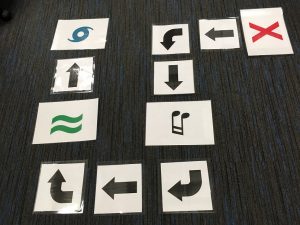Here are a few ideas for getting started with teaching computational thinking skills. Below there is a list of other places to go for ideas:
- Sequence parts of a story or the steps in a life skill, using objects, images, recordable buttons or actions. More able students can create their own algorithms by taking photos or writing/recording instructions.
- Create a dance algorithm for the class to follow using dance cards, or use different signals, e.g. a whistle, to change actions in a PE lesson. You can teach about repetition and selection too, e.g. if I blow the whistle, jump 5 times.
- Create a floor algorithm using arrows and symbols to denote different actions – students can also create their own rules for others to follow.

- Complete a Bubble Sort – this is a real-world algorithm to sort data. For example put 5 coins in a row and sort from smallest to largest amount. Compare the first two coins, and swap their positions if necessary. The compare the next two coins and repeat until the coins are sorted. This can be done to sort objects/images/sounds according to size, weight, texture, volume, number etc. Here is a video of a Bubble Sort in Lego.
- Create a simple program to play a tune – give each student a musical instrument, or tablet device with music app. Assign each student a colour, and use coloured cards to create a program to play a tune. You can also use this Scratch program here using coloured cards. Stick pupils’ sequences of cards to the board for them to play. There is a high contrast version using shapes here.
- Create clapping rhythms based on key words in a subject, for example Minibeasts. Practise repeating patterns and changing sequences.
- Program your teacher to make a jam sandwich! Good practise for giving accurate instructions. You can find the planning here. http://code-it.co.uk/csplanning.html.
Other useful places to find ideas:
The CAS Barefoot website has a section devoted to SEN specific activities.
Phil Bagge has some good ideas to teach algorithmic thinking that can be adapted for SEND learners. His CS Planning page has more ideas too.
See the http://sheffieldclc.net website for a write up of some lessons teaching SEN pupils computing ideas. It can be found under Blogs > SEN.
Ryan Hayes has shared his planning for unplugged activities here, including creating dance algorithms, knock knock jokes and life skills, using a Scratch Jr format.
The original idea for unplugged activities came from CS Unplugged – there are lots of ideas here for activities.
